Effect of Bio-Based, Mixed Ester Lubricant in Minimum Quantity Lubrication on Tool Wear and Surface Integrity in Ultra-Precision Fly-Cutting of KDP Crystals
Abstract
1. Introduction
2. Experimental Setup
2.1. Experimental Setup and Materials
2.2. Lubricants and Experimental Conditions
2.3. Experimental Characterization
3. Results and Discussion
3.1. Surface Quality and Morphological Characteristics
3.1.1. Surface Roughness Analysis Under Different Cutting Conditions
3.1.2. Surface Morphology of KDP Crystals Under Different Cutting Conditions
3.2. Tool Wear and Adhesion Mechanisms
3.2.1. Evolution of Tool Wear Under Dry Cutting and MQL Conditions
3.2.2. Adhesion Layer Formation and Elemental Distribution on Tool Surfaces Under Dry Cutting and MQL Conditions
3.3. Lubricating Film Formation and Composition Analysis
3.3.1. FTIR Spectroscopy of Functional Groups in BBMEL
3.3.2. XPS Analysis of Lubricant Adsorption on Worn Tool Surfaces with BBMEL
3.3.3. Mechanism of Lubricating Film Formation in MQL Cutting
3.4. Effect of BBMEL on the Surface Integrity of KDP Crystals
4. Conclusions
- (1)
- MQL-BBMEL exhibited significantly better performance than MQL-HCBSL in enhancing surface quality when compared to dry cutting, achieving reductions of 27.77% in Sa and 44.76% in Sq. In contrast, MQL-HCBSL showed reductions of 16.94% in Sa and 27.55% in Sq under the same conditions. This superior efficacy of MQL-BBMEL in minimizing surface defects, such as scratches and grooves, is attributed to the formation of stable lubricating films facilitated by polar functional groups. These films effectively reduced groove formation, adhesion, and point defects, while also improving heat dissipation and chip removal efficiency.
- (2)
- MQL-BBMEL exhibited notably superior performance in minimizing tool wear, achieving a 25.16% reduction compared to dry cutting, which significantly surpassed the 14.71% reduction attained by MQL-HCBSL. This improvement is primarily due to MQL-BBMEL’s lower viscosity and active functional groups (-OH, R-CH2-R′, and R-COO-R′), which enhance atomization and penetration into the cutting zone. These characteristics promote the formation of robust and uniform lubricating films, effectively minimizing adhesion, reducing friction, and improving wear resistance, especially in worn tools.
- (3)
- GIXRD and Raman spectroscopy confirm that MQL-BBMEL prevents KDP deliquescence, surface fogging, and impurity adsorption. This stability stems from the lubricant’s minimal water content and composition of saturated fatty acids and lipids, which lack reactive groups for KDP interaction.
Author Contributions
Funding
Data Availability Statement
Acknowledgments
Conflicts of Interest
References
- Deng, L.; Yang, H.; Zeng, X.; Wu, B.; Liu, P.; Wang, X.; Duan, J. Study on mechanics and key technologies of laser nondestructive mirror-separation for KDP crystal. Int. J. Mach. Tools Manuf. 2015, 94, 26–36. [Google Scholar] [CrossRef]
- Li, C.; Zhang, Y.; Zhou, G.; Wei, Z.; Zhang, L. Theoretical modelling of brittle-to-ductile transition load of KDP crystals on (001) plane during nanoindentation and nanoscratch tests. J. Mater. Res. Technol. 2020, 9, 14142–14157. [Google Scholar] [CrossRef]
- Nakamoto, T.; Takahashi, C.; Furukawa, T. Polishing of Potassium Dihydrogen Phosphate Single Crystal in Saturated Solution by Laser Beam Scanning:—Polishing Conditions and Surface Roughness&mdash. J. Jpn. Soc. Precis. Eng. 2015, 81, 763–767. [Google Scholar] [CrossRef]
- Ji, F.; Xu, M.; Wang, B.; Wang, C.; Li, X.; Zhang, Y.; Zhou, M.; Huang, W.; Wei, Q.; Tang, G.; et al. Preparation of methoxyl poly(ethylene glycol) (MPEG)-coated carbonyl iron particles (CIPs) and their application in potassium dihydrogen phosphate (KDP) magnetorheological finishing (MRF). Appl. Surf. Sci. 2015, 353, 723–727. [Google Scholar] [CrossRef]
- Namba, Y.; Katagiri, M. Ultraprecision grinding of potassium dihydrogen phoshate crystals for getting optical surfaces. In Laser-Induced Damage in Optical Materials: 1998; Exarhos, G.J., Guenther, A.H., Kozlowski, M.R., Lewis, K.L., Soileau, M.J., Eds.; SPIE: Bellingham, WA, USA, 1999; Volume 3578, pp. 692–693. [Google Scholar] [CrossRef]
- Hou, N.; Zhang, L.C.; Zhang, Y.; Zhang, F.H. On the Ultra-Precision Fabrication of Damage-Free Optical KDP Components: Mechanisms and Problems. Crit. Rev. Solid State Mat. Sci. 2019, 44, 283–297. [Google Scholar] [CrossRef]
- Li, C.; Piao, Y.; Hu, Y.X.; Wei, Z.Z.; Li, L.Q.; Zhang, F.H. Modelling and experimental investigation of temperature field during fly-cutting of KDP crystals. Int. J. Mech. Sci. 2021, 210, 106751. [Google Scholar] [CrossRef]
- An, C.H.; Feng, K.; Wang, W.; Xu, Q.; Lei, X.Y.; Zhang, J.F.; Yao, X.L.; Li, H.B. Interaction Mechanism of Thermal and Mechanical Field in KDP Fly-Cutting Process. Micromachines 2021, 12, 855. [Google Scholar] [CrossRef]
- Yao, X.; Zhang, F.; Zhang, J.; Zhang, S.; Liao, D.; Lei, X.; Wang, J. Transient Stress-Induced Tool Wear Mechanisms and Adhesive Layer Formation in Single-Point Diamond Fly-Cutting of KDP Crystals. Mater. Today Commun. 2025, 43, 111648. [Google Scholar] [CrossRef]
- Hu, L.; Wang, Z.; Wang, J.; Wang, Y. Derivative analysis and evaluation of roll-slip fretting wear mechanism of ultra-thin-walled bearings under high service. Wear 2025, 562, 205630. [Google Scholar] [CrossRef]
- Hu, L.; Li, B.; Wang, Z.; Wang, Y. Analysis and evaluation of multi-state wear mechanism of elastic-flexible thin-walled bearings. Tribol. Int. 2025, 202, 110293. [Google Scholar]
- Hu, L.; Pueh, L.H.; Wang, Z.; Wang, Y. Surface Performance Control and Evaluation of Precision Bearing Raceway with Wireless Sensing CBN Grinding Wheel. Wear 2025, 568, 205966. [Google Scholar]
- Lai, H.; Pengyang, J.; Zixi, W.; Yuming, W. Study on type of magnetic suspension rotor groove and wear of drop touchdown bearing. Eng. Appl. Comput. Fluid. Mech. 2024, 18, 2422065. [Google Scholar]
- Fuchs, B.A.; Hed, P.P.; Baker, P.C. Fine diamond turning of KDP Crystals. Appl. Opt. 1986, 25, 1733–1735. [Google Scholar] [CrossRef]
- Kozlowski, M.R.; Thomas, I.M.; Edwards, G.J.; Stanion, K.A.; Latanich, L. Influence of diamond turning and surface cleaning processes on the degradation of KDP crystal surfaces. Proc. SPIE 1991, 1561, 59–69. [Google Scholar]
- Lawal, S.A.; Choudhury, I.A.; Nukman, Y. A critical assessment of lubrication techniques in machining processes: A case for minimum quantity lubrication using vegetable oil-based lubricant. J. Clean. Prod. 2013, 41, 210–221. [Google Scholar] [CrossRef]
- Li, G.X.; Chandra, S.; Rashid, R.; Palanisamy, S.; Ding, S.L. Machinability of additively manufactured titanium alloys: A comprehensive review. J. Manuf. Process. 2022, 75, 72–99. [Google Scholar] [CrossRef]
- Sílvia, R.C.; Lauro, C.H.; Ana, H.; Davim, J.P. Development of FEM-based digital twins for machining difficult-to-cut materials: A roadmap for sustainability. J. Manuf. Process. 2022, 75, 739–766. [Google Scholar] [CrossRef]
- Wang, Y.; Liu, C.F. State-of-the-art on minimum quantity lubrication in green machining. J. Clean. Prod. 2023, 429, 139613. [Google Scholar] [CrossRef]
- Saha, S.; Deb, S.; Bandyopadhyay, P.P. Shadow zone in MQL application and its influence on lubricant deficiency and machinability during micro-milling. Int. J. Mech. Sci. 2022, 220, 107181. [Google Scholar] [CrossRef]
- Saha, S.; Deb, S.; Bandyopadhyay, P.P. Progressive wear based tool failure analysis during dry and MQL assisted sustainable micro-milling. Int. J. Mech. Sci. 2021, 212, 106844. [Google Scholar] [CrossRef]
- Saha, S.; Deb, S.; Bandyopadhyay, P.P. An analytical approach to assess the variation of lubricant supply to the cutting tool during MQL assisted high speed micromilling. J. Mater. Process. Technol. 2020, 285, 116783. [Google Scholar] [CrossRef]
- Sayuti, M.; Erh, O.M.; Sarhan, A.A.; Hamdi, M. Investigation on the morphology of the machined surface in end milling of aerospace AL6061-T6 for novel uses of SiO2 nanolubrication system. J. Clean. Prod. 2014, 66, 655–663. [Google Scholar] [CrossRef]
- Zhou, X.; He, L.; Yuan, S.; Deng, J.; Su, Z.; Yang, J.; Du, F. Experimental Research on the Effect of Thermophysical Characteristics of Cutting Fluid on Cutting Performance During Turning Ti-6Al-4V Alloy. Lubricants 2025, 13, 90. [Google Scholar] [CrossRef]
- Su, Y.; Gong, L.; Li, B.; Liu, Z.; Chen, D. Performance evaluation of nanofluid MQL with vegetable-based oil and ester oil as base fluids in turning. Int. J. Adv. Manuf. Technol. 2016, 83, 2083–2089. [Google Scholar] [CrossRef]
- Li, L.; Xu, J.; Guo, G.; Gupta, M.K.; Chen, M. Wear behavior of different coated tools in MQL-assisted milling of magnesium-based rare-earth alloys. J. Mater. Res. Technol. 2023, 27, 1665–1682. [Google Scholar] [CrossRef]
- Guo, S.; Li, C.; Zhang, Y.; Wang, Y.; Li, B.; Yang, M.; Zhang, X.; Liu, G. Experimental evaluation of the lubrication performance of mixtures of castor oil with other vegetable oils in MQL grinding of nickel-based alloy. J. Clean. Prod. 2017, 140, 1060–1076. [Google Scholar] [CrossRef]
- Xu, W.; Li, C.; Zhang, Y.; Ali, H.M.; Sharma, S.; Li, R.; Yang, M.; Gao, T.; Liu, M.; Wang, X.; et al. Electrostatic atomization minimum quantity lubrication machining: From mechanism to application. Int. J. Extreme Manuf. 2022, 4, 42003. [Google Scholar] [CrossRef]
- Luo, X.C.; Wu, S.J.; Wang, D.Z.; Yun, Y.X.; An, Q.L.; Li, C.H. Sustainable development of cutting fluids: The comprehensive review of vegetable oil. J. Clean. Prod. 2024, 473, 143544. [Google Scholar] [CrossRef]
- Uslu, G.; Korkmaz, M.E.; Elkilani, R.H.R.; Gupta, M.K.; Vashishtha, G. Investigation of tribological properties of inconel 601 under environmentally friendly MQL and Nano-Fluid MQL with pack boronizing. Lubricants 2024, 12, 353. [Google Scholar] [CrossRef]
- Kara, F. Investigation of the effect of Al2O3 nanoparticle-added MQL lubricant on sustainable and clean manufacturing. Lubricants 2024, 12, 393. [Google Scholar] [CrossRef]
- Zhang, X.; Li, C.; Zhou, Z.; Liu, B.; Zhang, Y.; Yang, M.; Gao, T.; Liu, M.; Zhang, N.; Said, Z.; et al. Vegetable Oil-Based Nanolubricants in Machining: From Physicochemical Properties to Application. Chin. J. Mech. Eng. 2023, 36, 76. [Google Scholar] [CrossRef]
- Debnath, S.; Anwar, M.; Pramanik, A.; Basak, A.K. Nanofluid-minimum quantity lubrication system in machining: Towards clean manufacturing. In Sustainable Manufacturing; Elsevier: Amsterdam, The Netherlands, 2021; pp. 109–135. [Google Scholar] [CrossRef]
- Lisowicz, J.; Habrat, W.; Krupa, K. Influence of minimum quantity lubrication using vegetable-based cutting fluids on surface topography and cutting forces in finish turning of Ti-6Al-4V. Adv. Sci. Technol. Res. J. 2022, 16. [Google Scholar] [CrossRef]
- Farfan-Cabrera, L.I.; Rojo-Valerio, A.; Calderon-Najera, J.D.D.; Coronado-Apodaca, K.G.; Iqbal, H.M.; Parra-Saldivar, R.; Franco-Morgado, M.; Elias-Zuñiga, A. Microalgae oil-based metal working fluids for sustainable minimum quantity lubrication (MQL) operations—A perspective. Lubricants 2023, 11, 215. [Google Scholar] [CrossRef]
- Panda, D.; Kumari, K.; Dalai, N. Performance of Minimum Quantity Lubrication (MQL) and its effect on Dry Machining with the addition of Nano-particle with the biodegradable base fluids: A review. Mater. Today-Proc. 2022, 56, 1298–1301. [Google Scholar] [CrossRef]
- Zbek, N.A.; Zbek, O.; Kara, F.; Saruhan, H. Effect of Eco-Friendly Minimum Quantity Lubrication in Hard Machining of Vanadis 10: A High Strength Steel. Steel Res. Int. 2022, 93, 19. [Google Scholar]
- dos Santos Motta Neto, W.; Leal, J.E.; Arantes, L.J.; Arencibia, R.V. The effect of stylus tip radius on Ra, Rq, Rp, Rv, and Rt parameters in turned and milled samples. Int. J. Adv. Manuf. Technol. 2018, 99, 1979–1992. [Google Scholar]
- Dobes, J.; Leal, J.E.S.; Profeta, J.; de Sousa, M.M.; Neto, F.P.L.; Piratelli-Filho, A.; Arencibia, R.V. Effect of mechanical vibration on Ra, Rq, Rz, and Rt roughness parameters. Int. J. Adv. Manuf. Technol. 2017, 92, 393–406. [Google Scholar]
- Cui, Z.P.; Li, G.; Liu, H.Z.; Zong, W.J.; Zhang, H.J.; Zhang, C.Y.; Du, K. Tool anisotropic wear prediction and its influence on surface topography in diamond turning of oxygen-free copper. J. Mater. Process. Technol. 2023, 318, 118042. [Google Scholar] [CrossRef]
- Du, J.B.; Liu, H.Z.; Yang, N.; Chen, X.Z.; Zong, W.J. Modification of diamond tool by focused ion beam in dry single-point diamond turning. Appl. Surf. Sci. 2023, 637, 157882. [Google Scholar] [CrossRef]
- Yang, N.; Yang, X.; Huang, W.; Zhao, S.; Lei, D.J. Analysis of diamond tool wear mechanism in terms of stress for KDP Fly cutting. Mater. Today Commun. 2022, 30, 103146. [Google Scholar] [CrossRef]
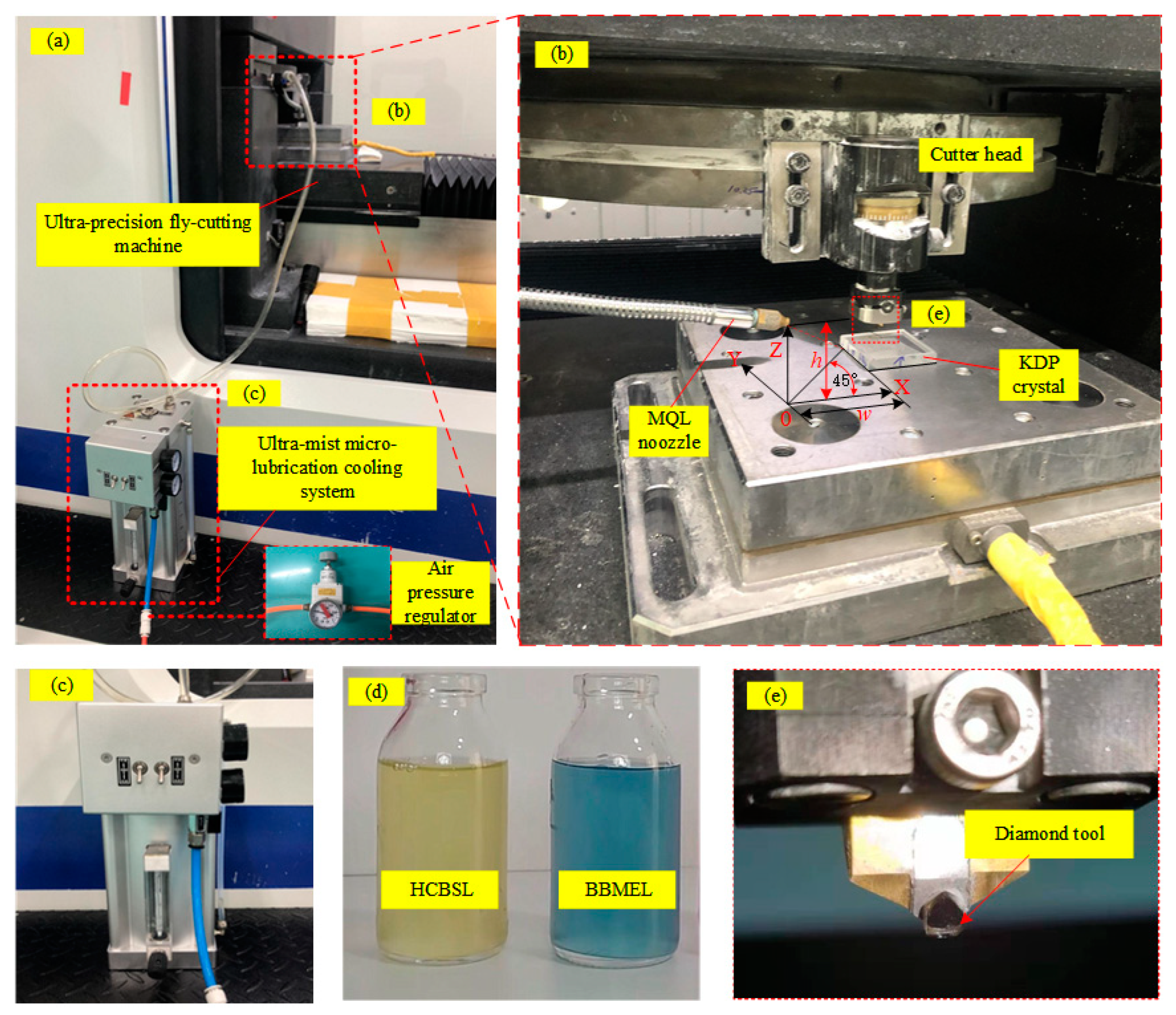
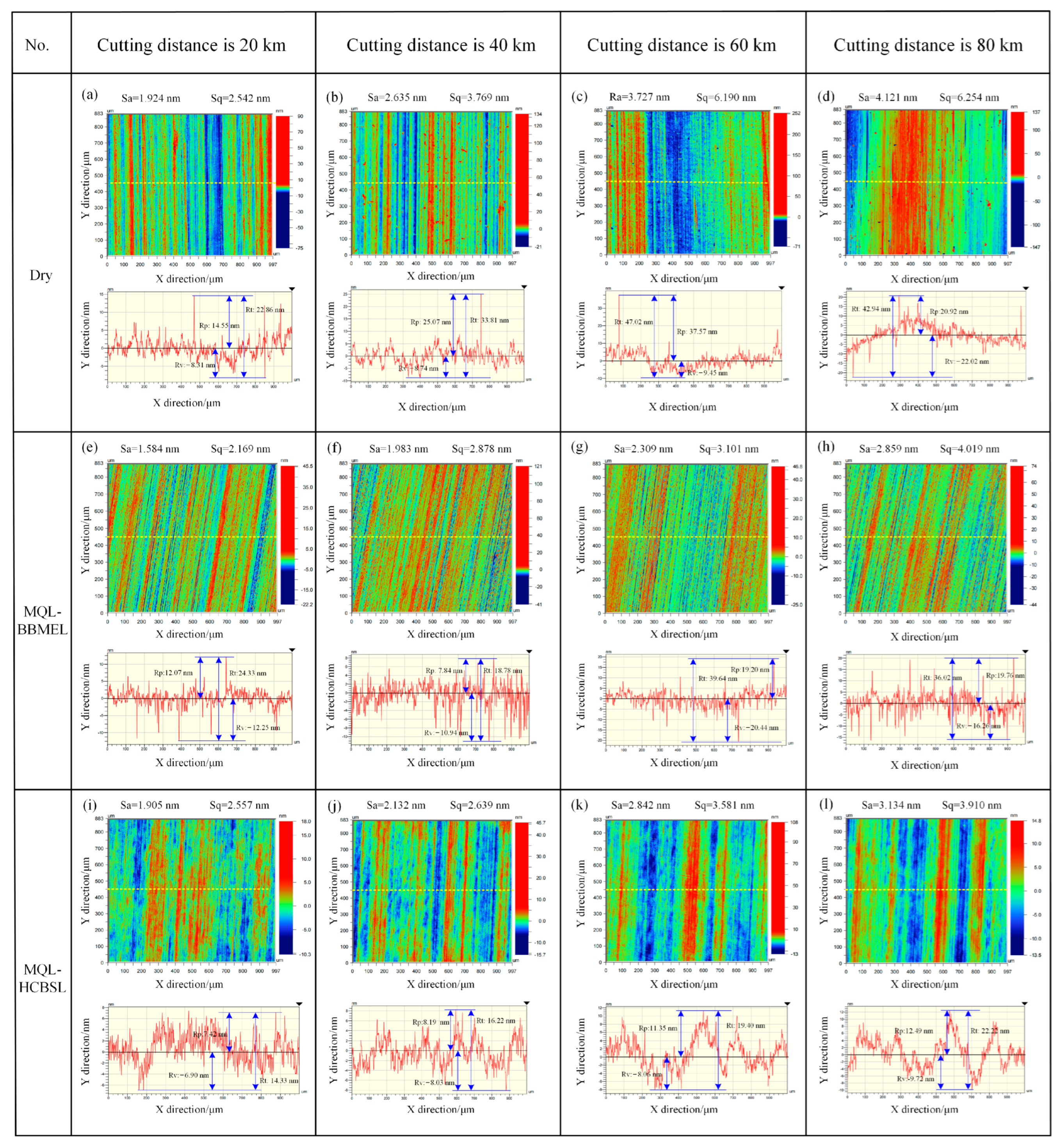
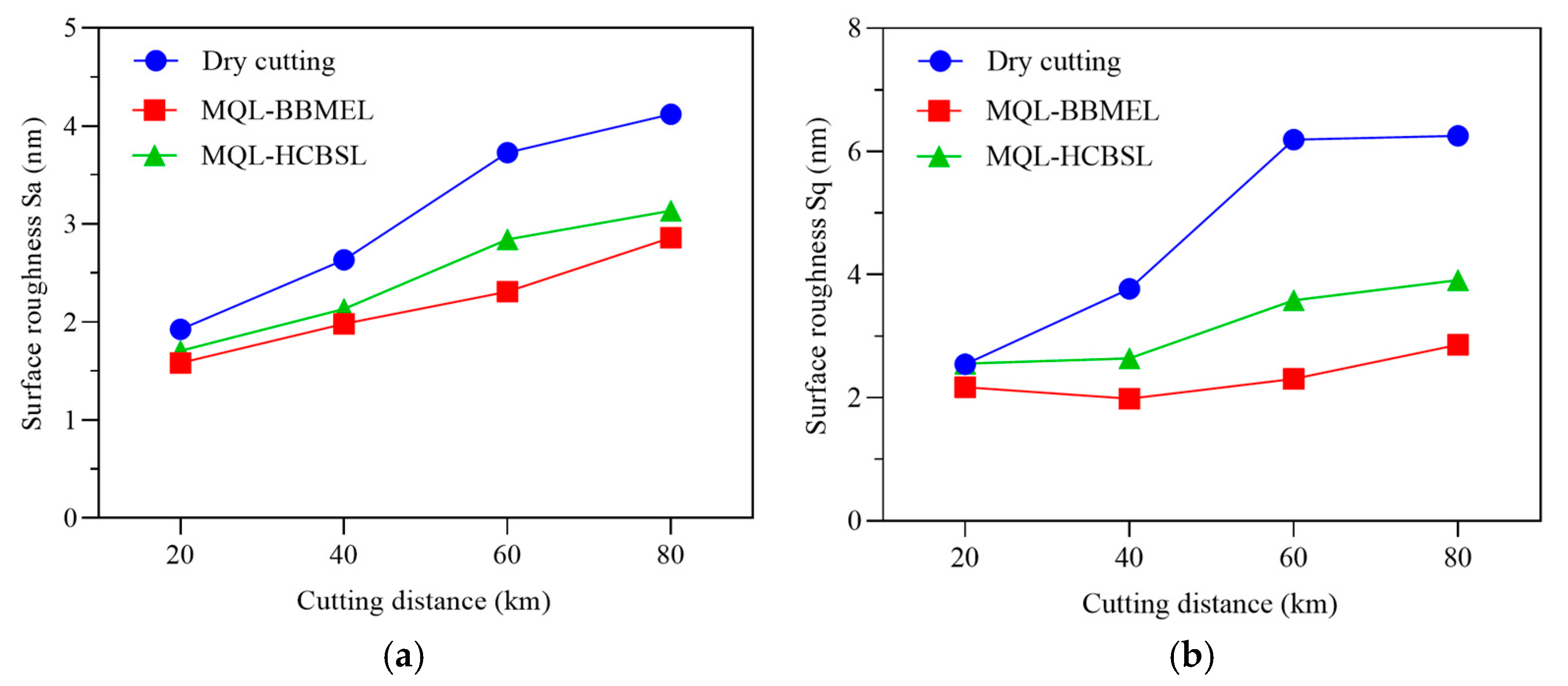
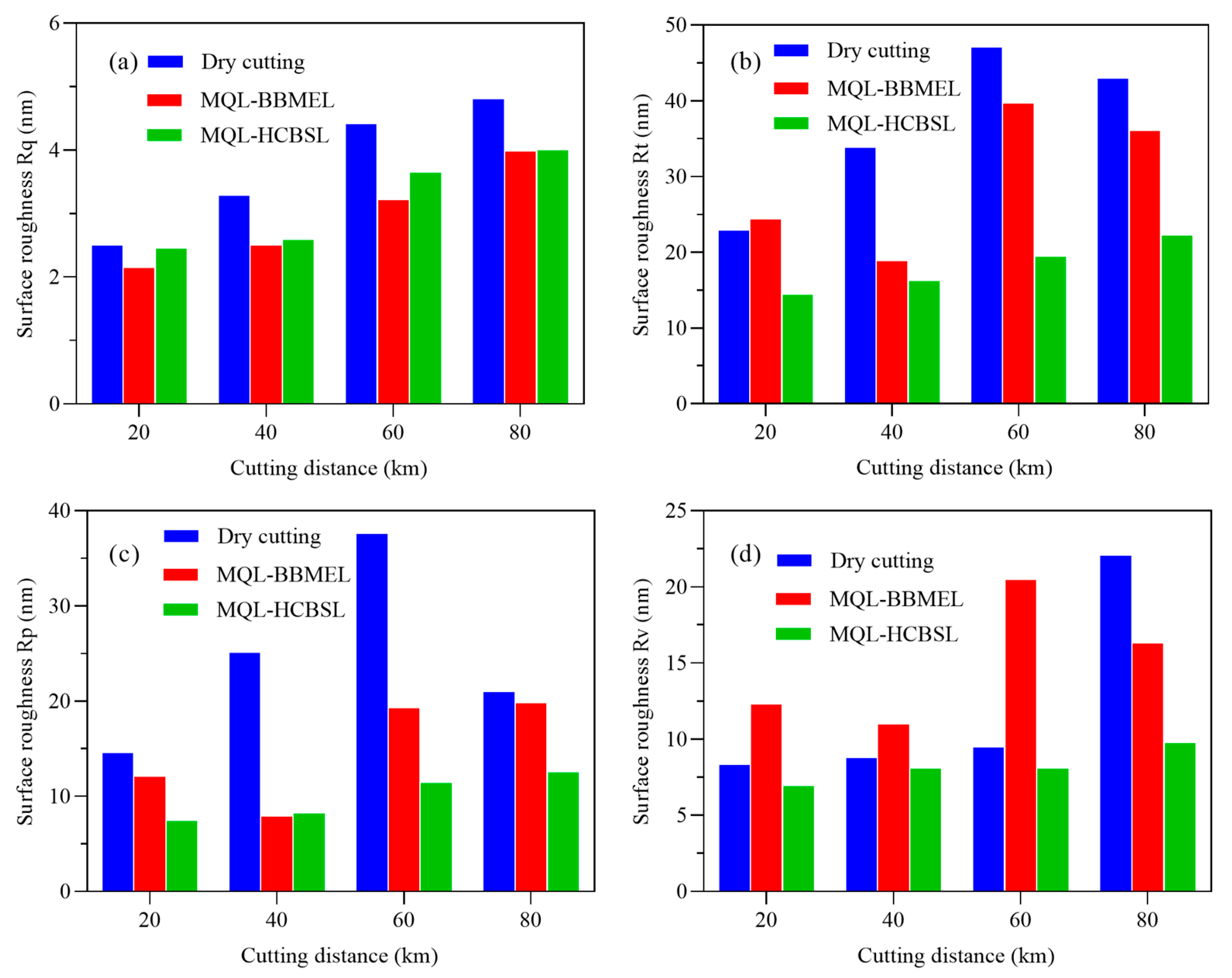
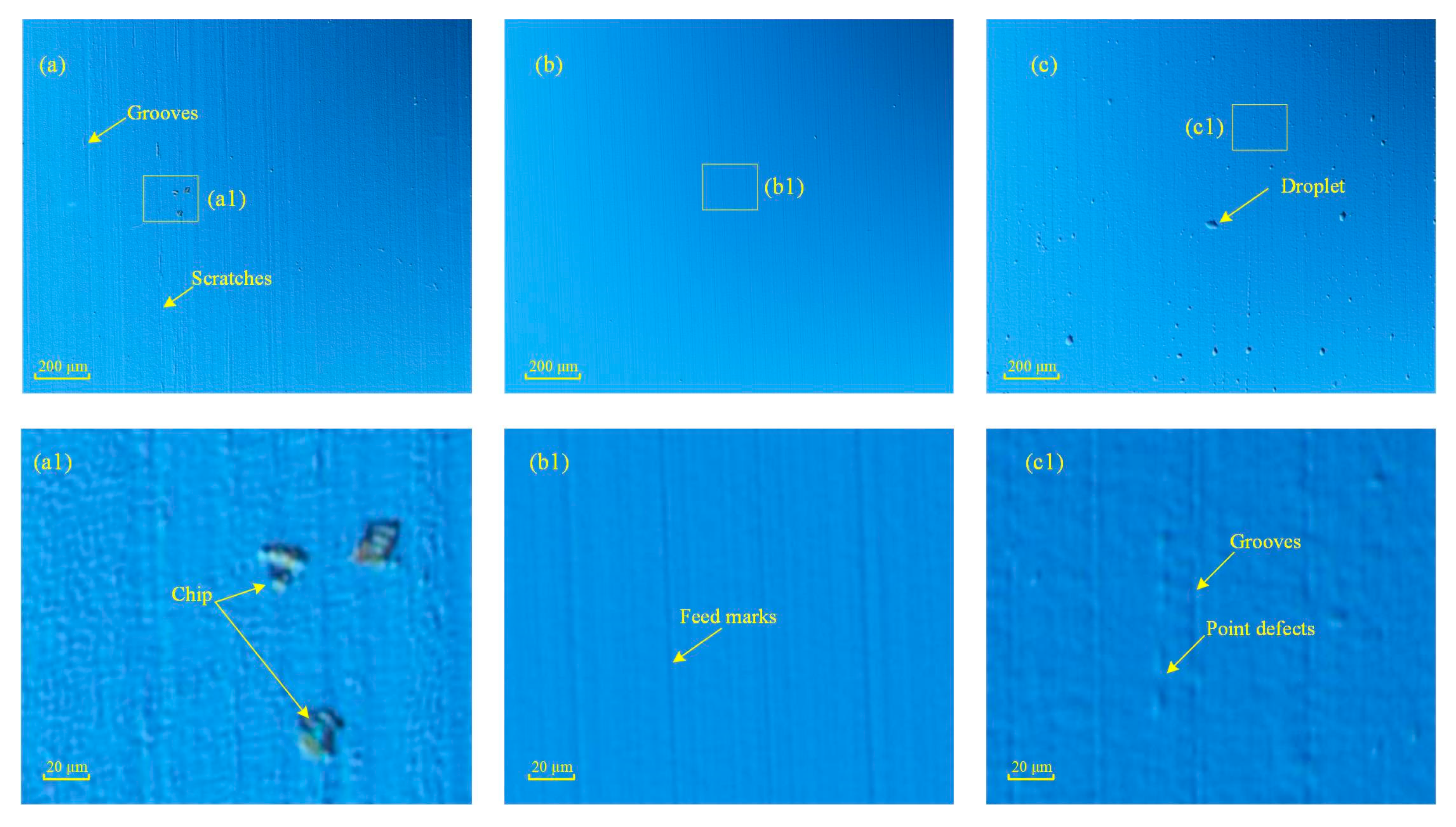
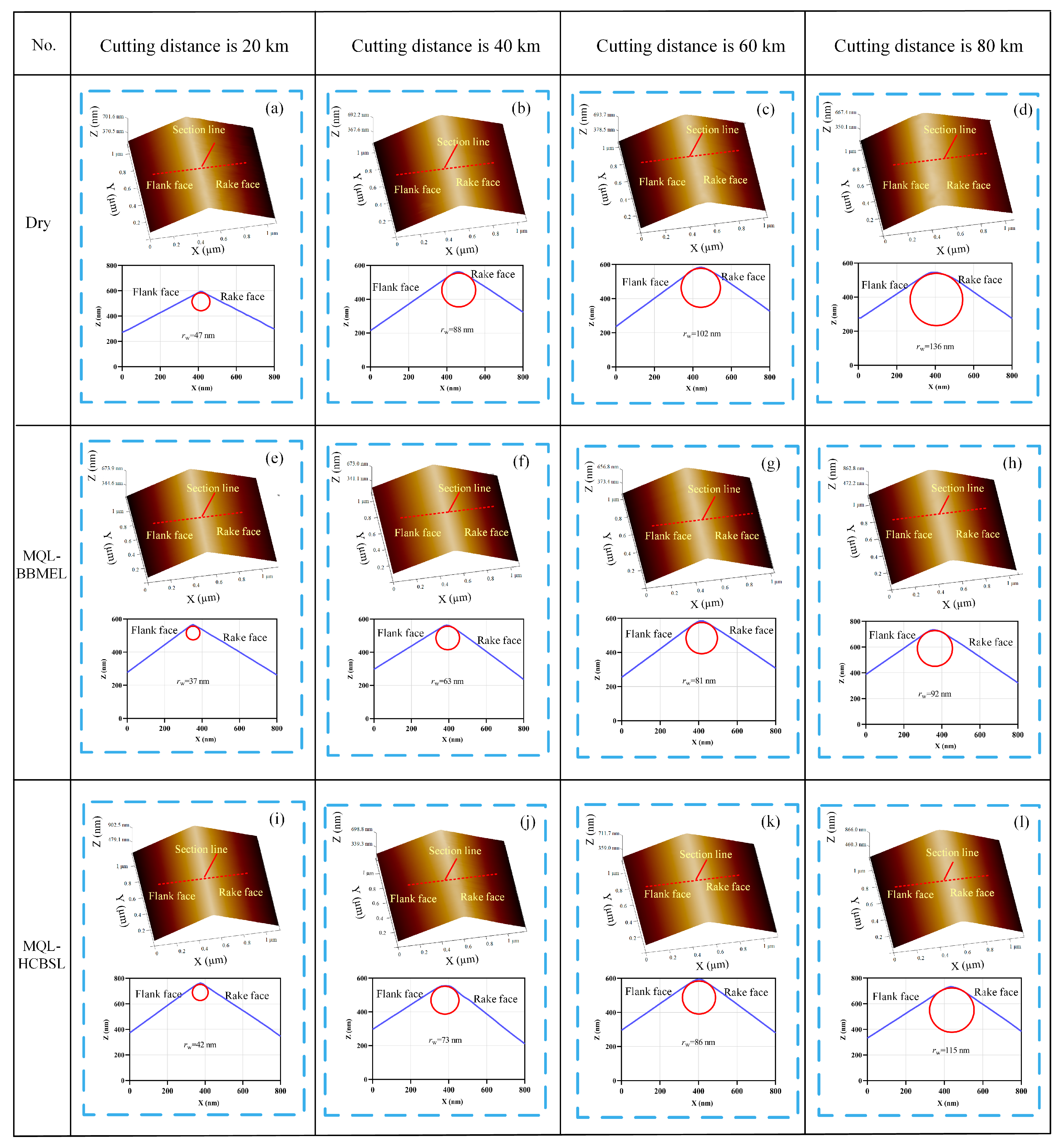
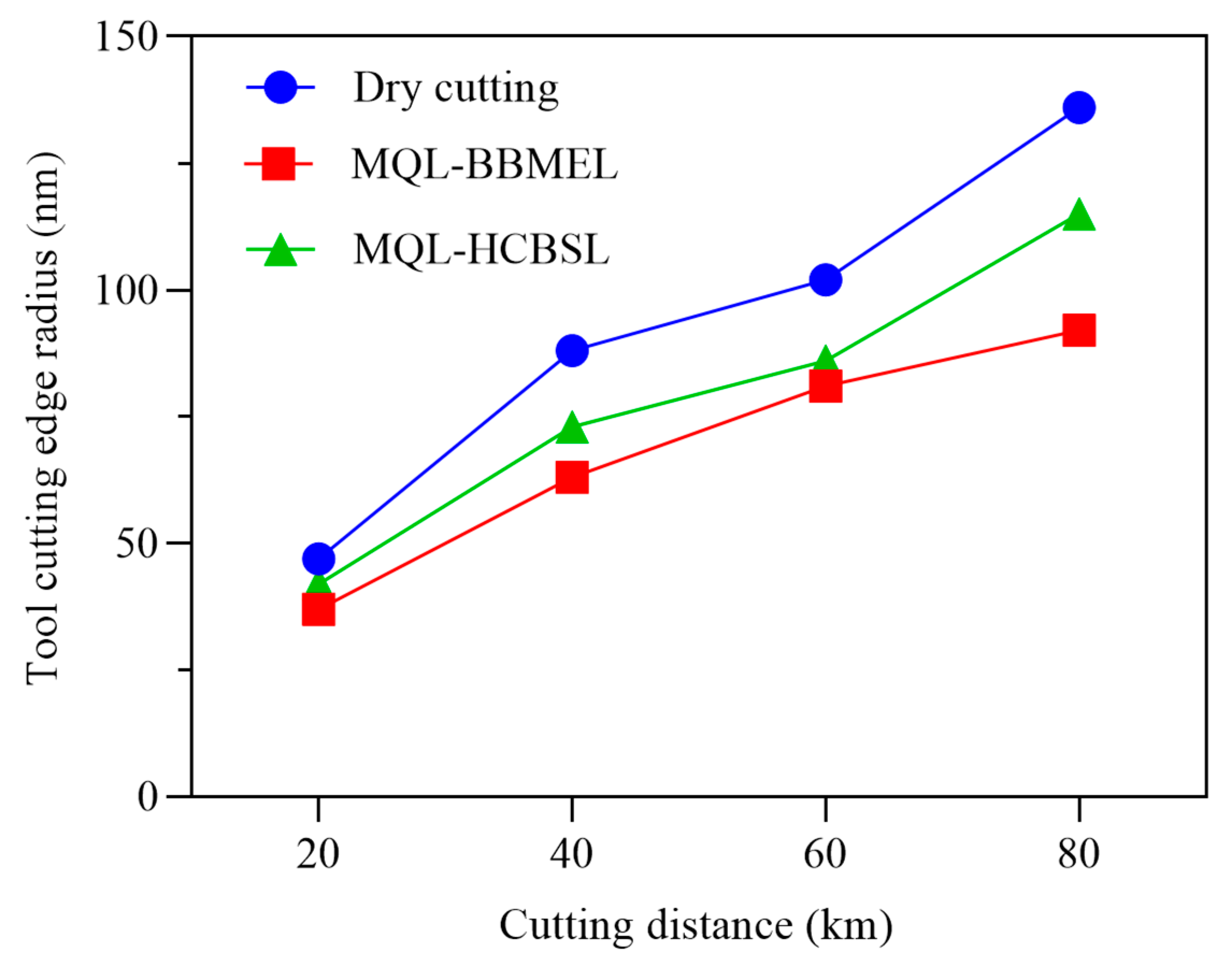
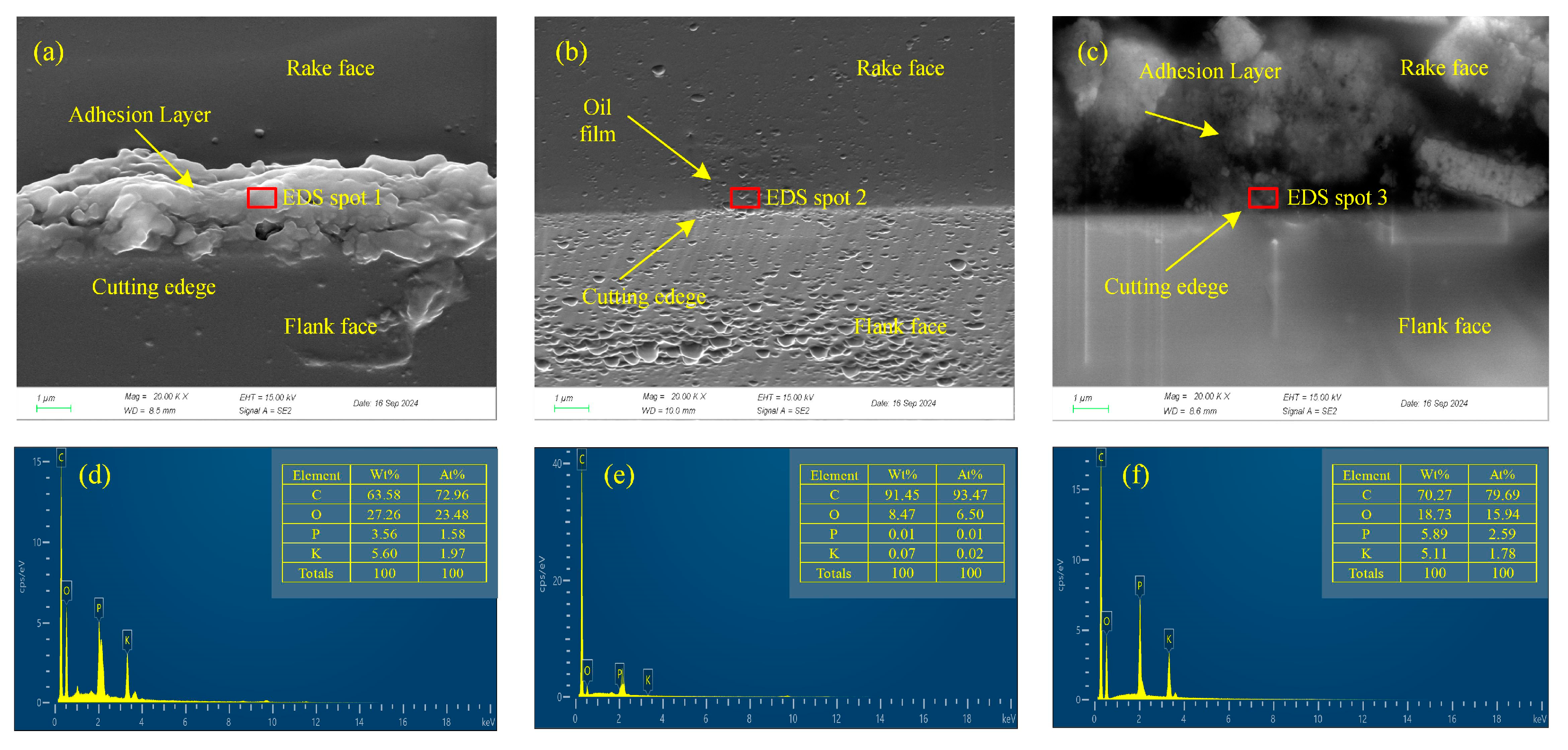
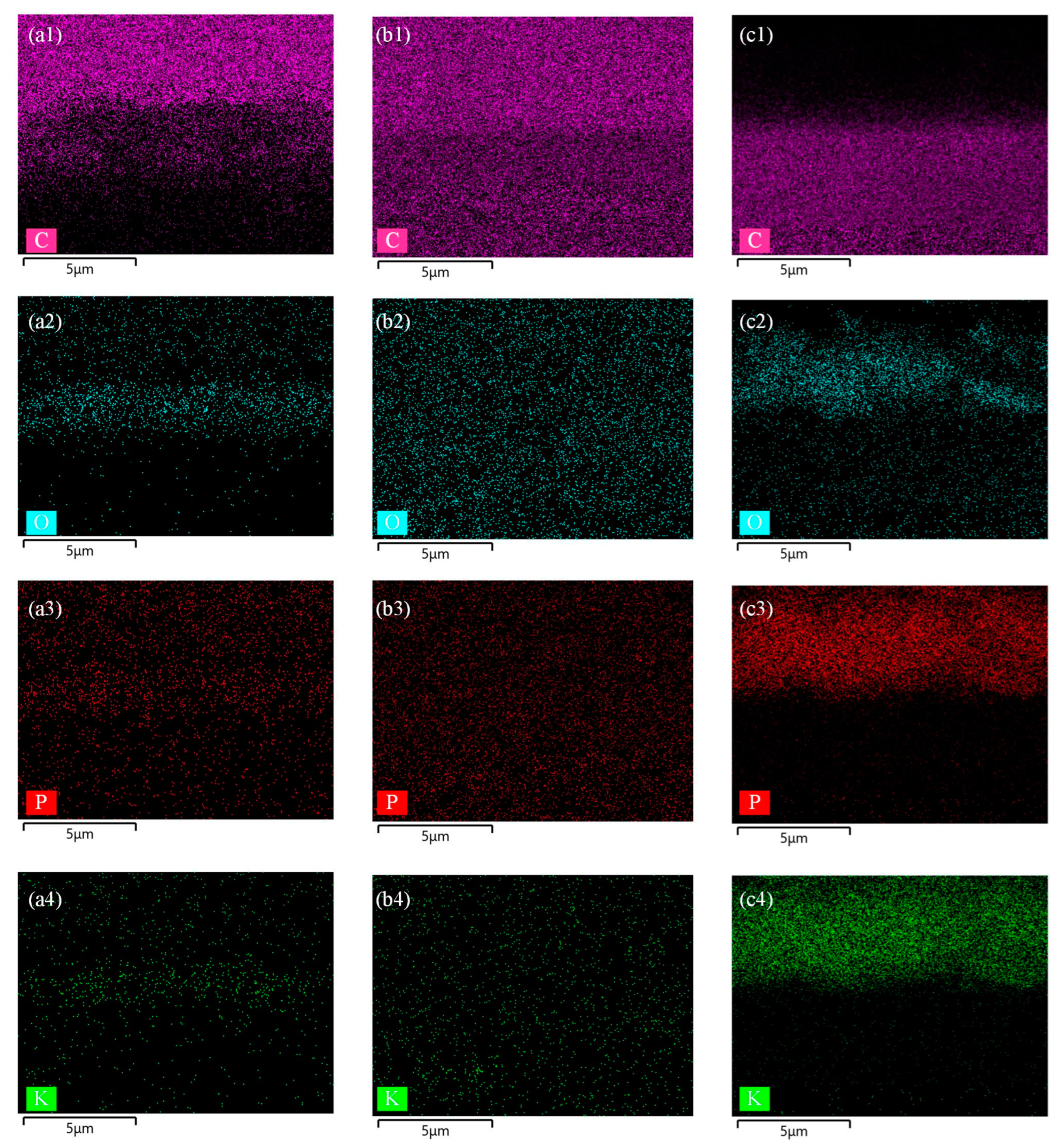
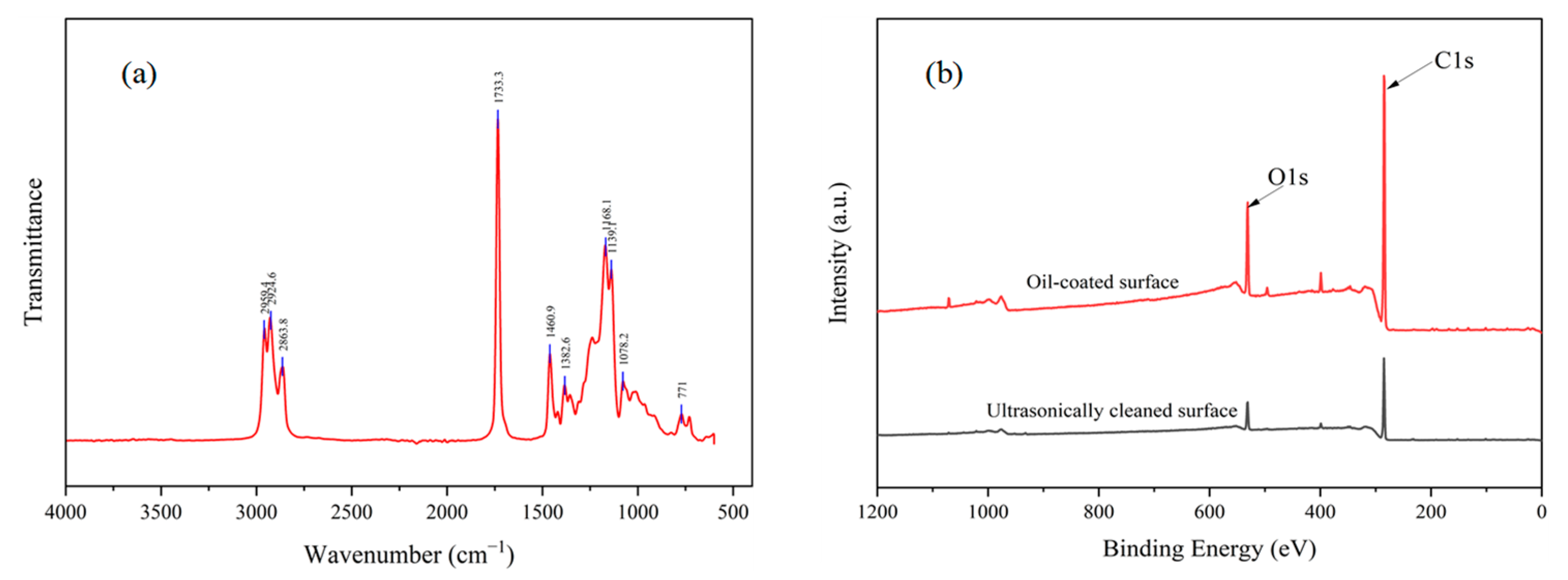
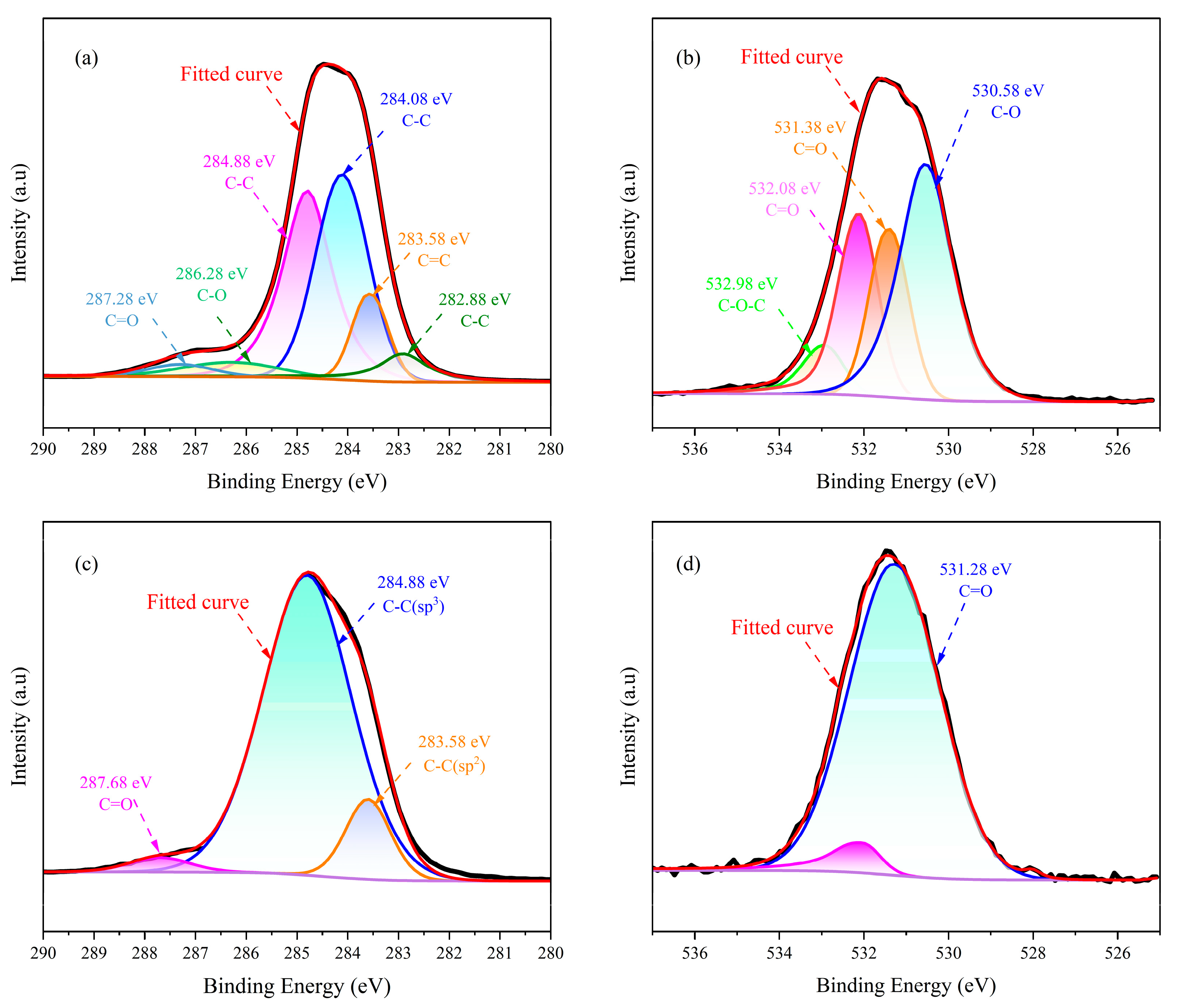
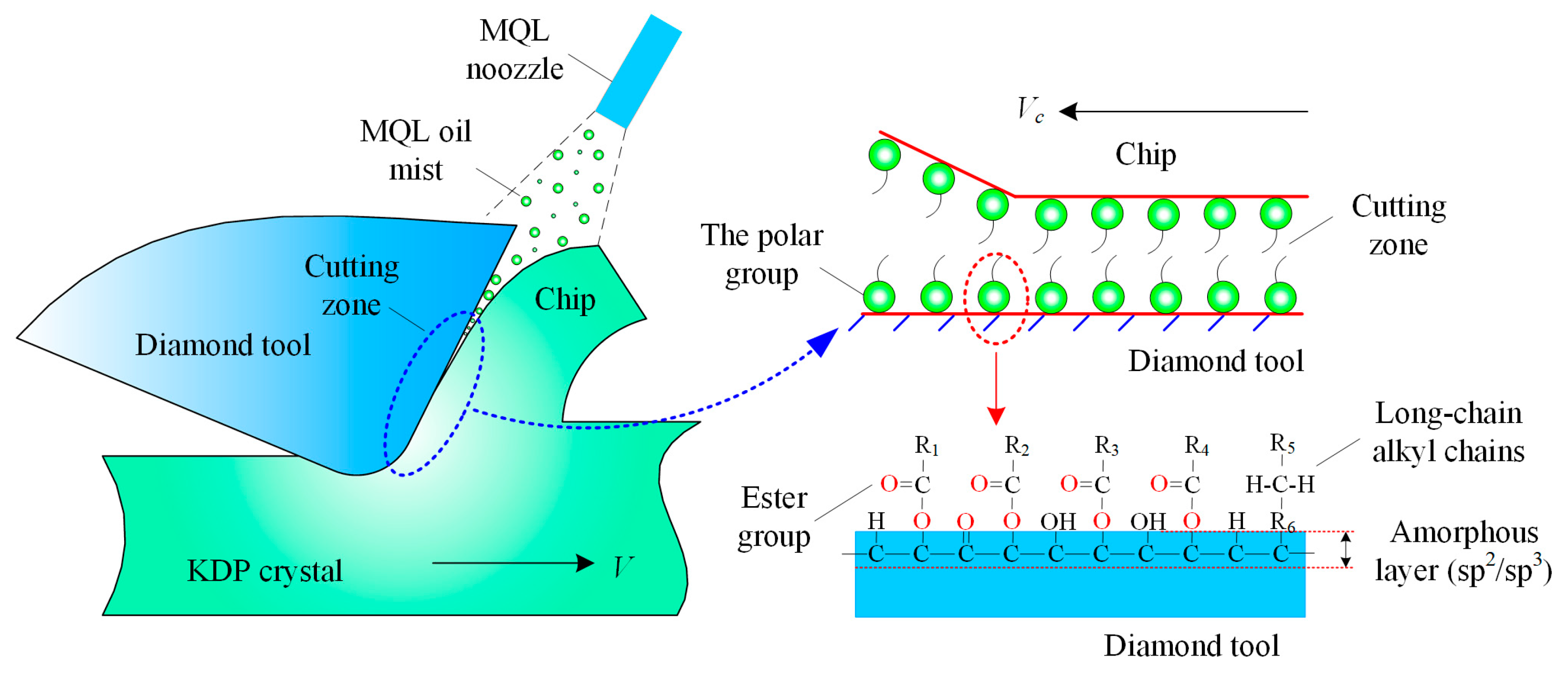
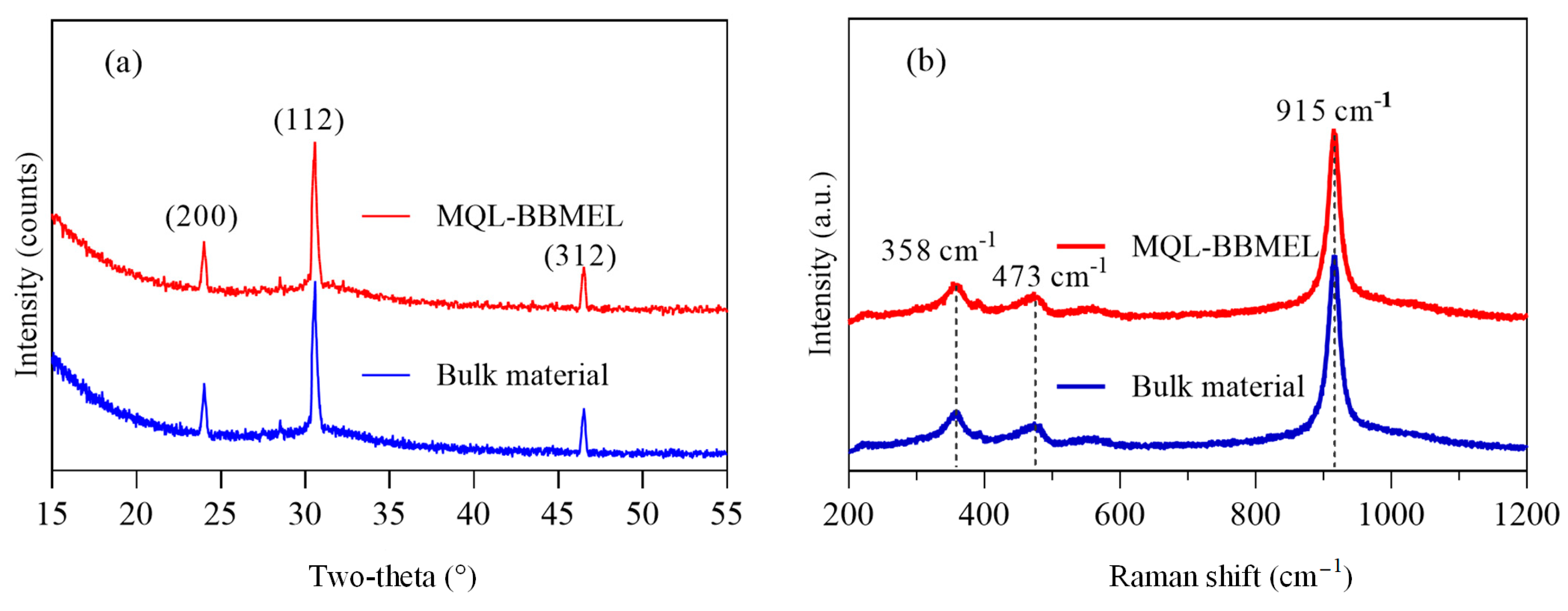
| Group | Cutting Method | Tool Numbers | Cutting Distances (km) |
|---|---|---|---|
| 1–4 | Dry | D1–D4 | 20, 40, 60, 80 |
| 5–8 | MQL-BBMEL | B1–B4 | 20, 40, 60, 80 |
| 9–12 | MQL-HCBSL | H1–H4 | 20, 40, 60, 80 |
| Properties of Lubricants | Base Composition | Chemical Formula | Kinematic Viscosity (mm2/s) | Water Content (ppm) | Flash Point (°C) |
|---|---|---|---|---|---|
| BBMEL | BBMEL: 93.25% Dioctyl Adipate, 3.24% Ethylene Glycol Laurate, 1.51% Castor Oil Ethoxylate, 2.00% Others | Dioctyl Adipate (C22H42O4), Ethylene Glycol Laurate (C14H28O3), Castor Oil Ethoxylate (C57H104O9 + nC2H4O, n varies) | 16 | 456 | 220 |
| HCBSL | HCBSL: 90.85% Hydrocarbon-based synthetic oily mixture, 3.74% Trimethylpentene, 2.82% Partially ethoxylated trimethylene derivative, 2.59% Others | Hydrocarbon-based synthetic oily mixture (C24H50), Trimethylpentene (C8H16), Partially ethoxylated trimethylene derivative (C3H6(OCH2CH3) OH) | 48 | 584 | 320 |
| Cutting speed (m/s) | 15 |
| Feed rate (μm/r) | 50 |
| Cutting depth (μm) | 5 |
| Cutting environment | Dry, MQL |
| Air pressure (μm) | 0.3 |
| Flow rate (mL/h) | 30 |
| Droplet size (μm) | 5 |
| Nozzle–workpiece edge distance (mm) | 110 |
| Nozzle height h (mm) | 58 |
| Nozzle horizontal distance w (mm) | 78 |
| Nozzle angle in X–Y plane | 45° |
Disclaimer/Publisher’s Note: The statements, opinions and data contained in all publications are solely those of the individual author(s) and contributor(s) and not of MDPI and/or the editor(s). MDPI and/or the editor(s) disclaim responsibility for any injury to people or property resulting from any ideas, methods, instructions or products referred to in the content. |
© 2025 by the authors. Licensee MDPI, Basel, Switzerland. This article is an open access article distributed under the terms and conditions of the Creative Commons Attribution (CC BY) license (https://creativecommons.org/licenses/by/4.0/).
Share and Cite
Yao, X.; Zhang, F.; Zhang, S.; Zhang, J.; Liao, D.; Lei, X.; Wang, J.; Du, J. Effect of Bio-Based, Mixed Ester Lubricant in Minimum Quantity Lubrication on Tool Wear and Surface Integrity in Ultra-Precision Fly-Cutting of KDP Crystals. Lubricants 2025, 13, 156. https://doi.org/10.3390/lubricants13040156
Yao X, Zhang F, Zhang S, Zhang J, Liao D, Lei X, Wang J, Du J. Effect of Bio-Based, Mixed Ester Lubricant in Minimum Quantity Lubrication on Tool Wear and Surface Integrity in Ultra-Precision Fly-Cutting of KDP Crystals. Lubricants. 2025; 13(4):156. https://doi.org/10.3390/lubricants13040156
Chicago/Turabian StyleYao, Xuelian, Feihu Zhang, Shuai Zhang, Jianfeng Zhang, Defeng Liao, Xiangyang Lei, Jian Wang, and Jianbiao Du. 2025. "Effect of Bio-Based, Mixed Ester Lubricant in Minimum Quantity Lubrication on Tool Wear and Surface Integrity in Ultra-Precision Fly-Cutting of KDP Crystals" Lubricants 13, no. 4: 156. https://doi.org/10.3390/lubricants13040156
APA StyleYao, X., Zhang, F., Zhang, S., Zhang, J., Liao, D., Lei, X., Wang, J., & Du, J. (2025). Effect of Bio-Based, Mixed Ester Lubricant in Minimum Quantity Lubrication on Tool Wear and Surface Integrity in Ultra-Precision Fly-Cutting of KDP Crystals. Lubricants, 13(4), 156. https://doi.org/10.3390/lubricants13040156




